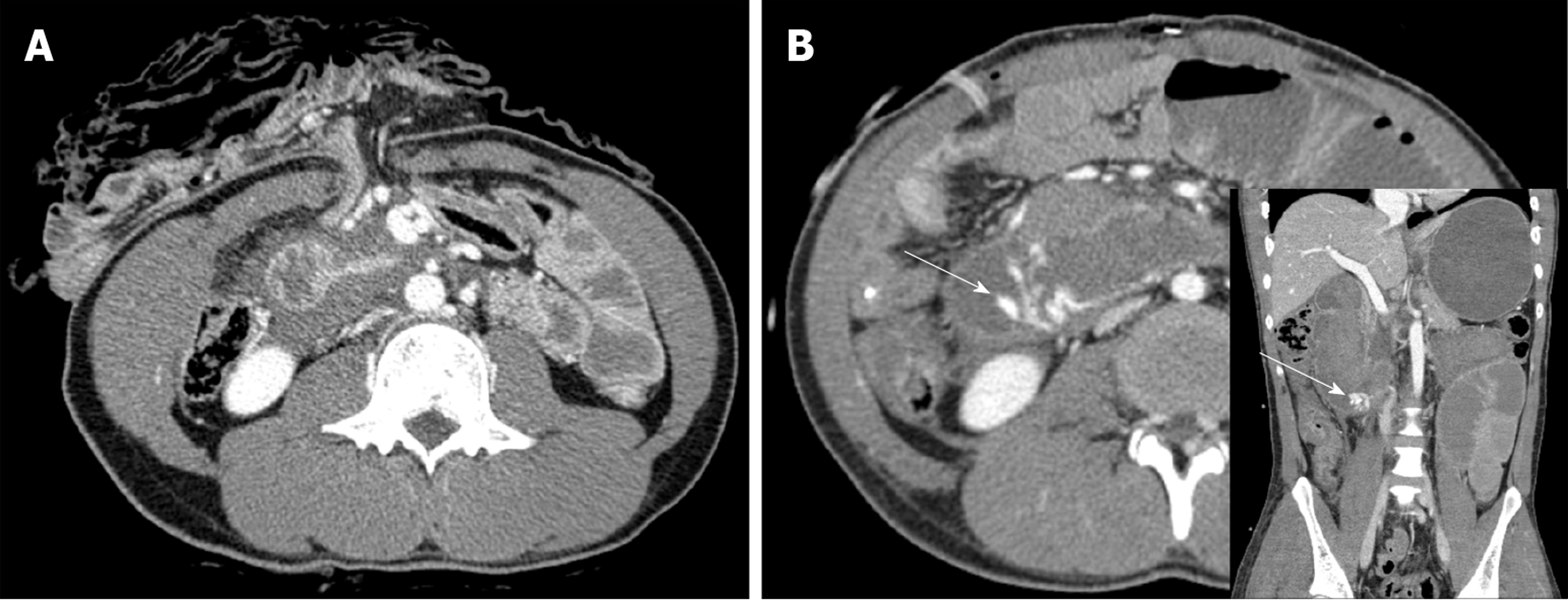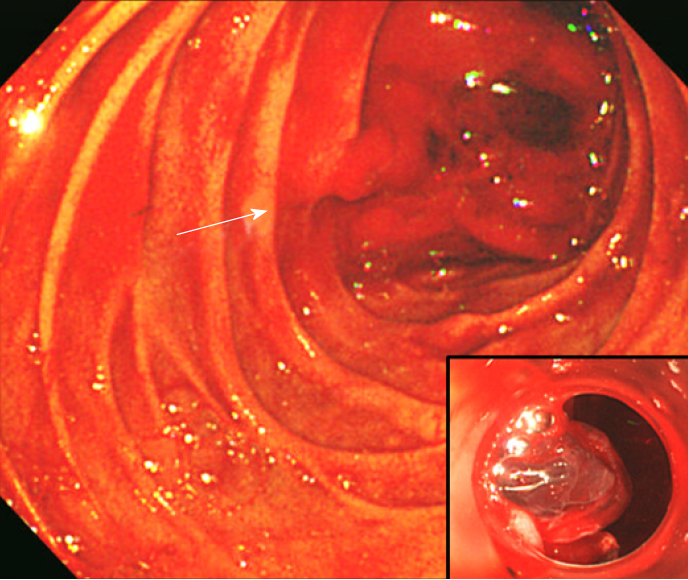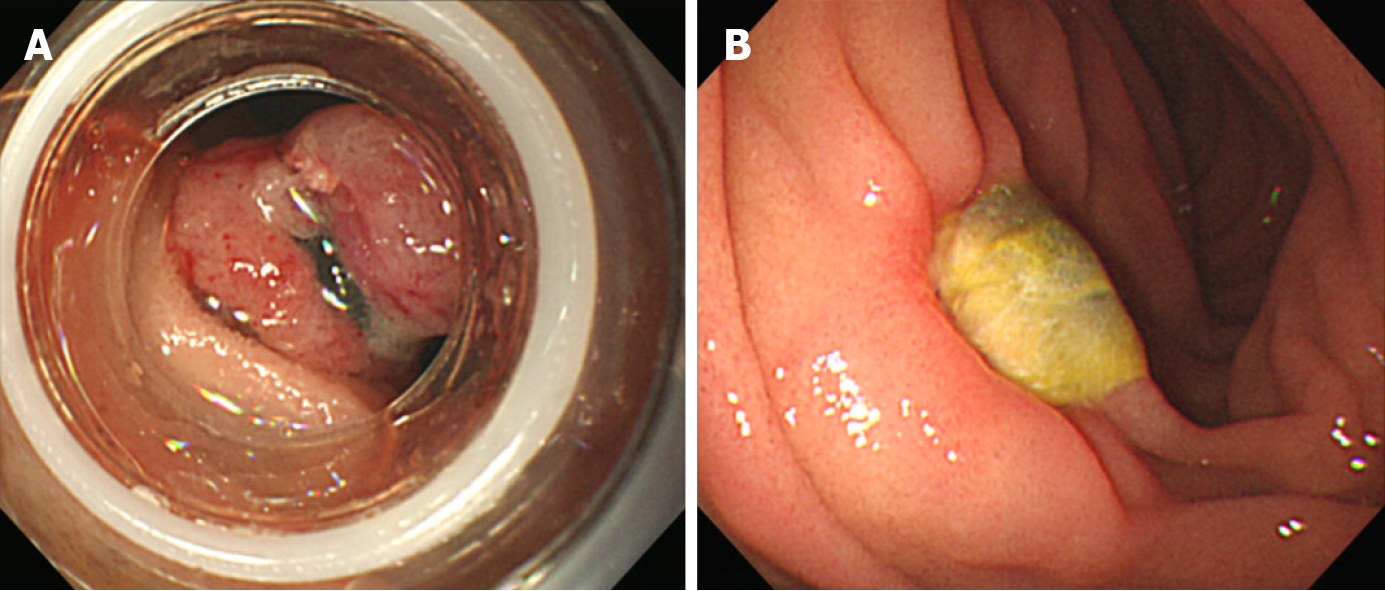Published online Oct 26, 2019. doi: 10.12998/wjcc.v7.i20.3271
Peer-review started: June 29, 2019
First decision: July 31, 2019
Revised: September 18, 2019
Accepted: October 5, 2019
Article in press: October 5, 2019
Published online: October 26, 2019
Processing time: 121 Days and 1 Hours
A penetrating injury of a hollow viscus is an obvious indication for an exploratory laparotomy, but is not typically an indication for endoscopic treatment.
A 27-year-old man visited the emergency department with a self-inflicted abdominal stab wound. Injuries to the colon and ileum were detected, but an injury to the second portion of the duodenum was missed. On the day following admission to our institution, the patient became hemodynamically unstable with massive hematochezia, although there was no evidence of bleeding in the Levin tube or Jackson-Pratt drain. We thus performed an upper gastrointestinal endoscopy and discovered a missed duodenal injury that was actively bleeding. An endoscopic band ligation was performed for hemostasis and closure of the perforation. The patient was subsequently discharged without any complications.
A penetrating injury of the duodenum can be overlooked, so careful abdominal exploration is very important. If a missed duodenal injury is suspected, a cautious endoscopic approach may be helpful.
Core tip: Following a penetrating abdominal injury, it is very important for surgeons to find all associated lesions. Insufficient abdominal exploration can result in a missed injury, occasionally leading to the need for reoperation and possibly a fatal outcome. We successfully treated a rare case of perforation and bleeding in the third portion of the duodenum, which was not found by upper-abdominal exploration during the initial surgery. If a missed hollow viscus injury, particularly in the duodenum, remains despite such efforts, an endoscopic approach may be helpful in some cases.
- Citation: Kim DH, Choi H, Kim KB, Yun HY, Han JH. Endoluminal closure of an unrecognized penetrating stab wound of the duodenum with endoscopic band ligation: A case report. World J Clin Cases 2019; 7(20): 3271-3275
- URL: https://www.wjgnet.com/2307-8960/full/v7/i20/3271.htm
- DOI: https://dx.doi.org/10.12998/wjcc.v7.i20.3271
Hollow viscus perforations cause considerable mortality and usually require emergency surgery. Rapid diagnosis and treatment of these conditions are essential to reduce the high morbidity and mortality associated with a late-stage presentation[1]. The majority of missed hollow viscus injuries result from blunt abdominal trauma, with those resulting from stab-penetrating abdominal trauma less prevalent[2]. However, because the duodenum is a retroperitoneal organ, a penetrating duodenal injury can be overlooked. Injuries to the duodenum are associated with high mortality, often associated with a delayed diagnosis[3]. A penetrating intestinal injury is an obvious indication for a laparotomy, but endoscopic treatment is extremely rare[4,5]. Endoscopic treatment for a penetrating intestinal injury is rare because the endoscopic approach is difficult, peritonitis may be exacerbated during the procedure, and peritonitis cannot be resolved by endoscopic treatment[6]. There has been one report of endoscopic treatment for a penetrating gastric injury[7]. However, there have been no reports of endoscopic treatment for a penetrating duodenal injury. Herein, we present the first report of a case of a penetrating duodenal injury treated with endoscopy.
A 27-year-old male requested transfer for a self-inflicted abdominal stab wound.
The patient had stabbed himself in his upper abdomen with a kitchen knife three times, in front of his family. He then visited the emergency room at another hospital, from which he was transferred to our emergency room. According to his family, he was uncontrollable when angry.
The patient denied a history of hypertension, diabetes mellitus, viral hepatitis, or tuberculosis. He had no known drug or food allergies. He also denied a history of operation, trauma, or blood transfusion.
The patient’s vital signs upon arrival were as follows: Blood pressure 100/60 mmHg, heart rate 88 beats/min, respiratory rate 12 times/min, body temperature 37 °C, and oxygen saturation 98% on room air. He was awake, alert, and oriented. However, he complained of tenderness throughout the entire abdomen. We found three stab wounds in the upper-abdominal area. Two stab wounds had not penetrated the peritoneum, but the third had penetrated the peritoneum. There was a 3-cm longitudinal wound in the upper midline abdominal area, and the small bowel and transverse colon were eviscerated.
A complete blood count was obtained showing a white blood cell count of 13.3 × 106/L, hemoglobin 15.3 g/dL, and a platelet count of 229 × 109/L. Electrolyte, coagulation, and blood biochemical tests were all normal.
The three wounds in the middle of the upper abdomen were inspected. An exploratory laparotomy detected two perforations in the ileum and mid-transverse colon, which were repaired primarily (Figure 1A). One day after the surgery, the patient became hemodynamically unstable with massive hematochezia, although there was no evidence of bleeding in the Levin tube or Jackson-Pratt (JP) drain. Eight pints of packed red blood cells were transfused, but his hemoglobin value decreased from 10 to 8 mg/dL. Systolic blood pressure was < 80 mg and the patient’s consciousness became unclear. The patient was intubated and transferred to the intensive care unit. An abdominopelvic computed tomography (CT) scan revealed extravasation of contrast medium in the third duodenal portion (Figure 1B). An endoluminal approach for the endoscopic examination was performed in the intensive care unit to identify the bleeding lesions during preparation for the second operation. It showed a large blood clot on the third duodenum; a perforation 0.3 cm in diameter with active bleeding medially into the third duodenal portion was detected (Figure 2).
An unrecognized penetrating stab wound in the third portion of the duodenum.
Several attempts to seal the perforation and stop the bleeding with endoclips failed due to the tangential angle. Next, an endoscopic band ligation (EBL) technique was used to obtain hemostasis and closure of the lesion using a pneumo-active single-band ligator (MD-48709; Akita Sumitomo Bakelite, Tokyo, Japan) (Figure 3A). After EBL, the patient’s hemodynamics stabilized, and no adverse events occurred. Endoscopy 9 d later showed a healing ulcer at the perforation site closed by EBL (Figure 3B).
After EBL, the patient was hemodynamically stable, and there was no evidence of peritonitis or bleeding. He resumed a normal diet 5 d after EBL and was discharged 9 d after surgery.
Duodenal injuries are relatively infrequent compared to injuries to other intra-abdominal organs, and most duodenal injuries are penetrating injuries. However, a duodenal injury is often diagnosed late because part of the duodenum is retroperitoneal. In addition, a duodenal injury can be missed, resulting in delayed treatment and increased mortality and morbidity[3,8]. In the present case, the small bowel and transverse colon were eviscerated at the time the patient arrived at the emergency department. Penetrating injuries to the terminal ileum and transverse colon were detected, and there was no active bleeding into the abdominal cavity. However, the patient became hemodynamically unstable on the day after surgery. The Levin tube and JP drain were clear, but he defecated massive hematochezia. We performed an upper gastrointestinal endoscopy and discovered a missed duodenal injury with active bleeding in the third portion of the duodenum. After endoscopic treatment, we reviewed the initial abdominal pelvic CT scan and detected intra-luminal bleeding in the third portion of the duodenum. We missed the duodenal injury because there was no bile contamination or bleeding into the abdominal cavity during the operation. A hollow viscus injury manifesting with intra-luminal bleeding but no peritonitis or hemoperitoneum is an extremely rare condition. Retroperitoneal organ injuries resulting from a penetrating abdominal injury tend to be overlooked, as occurred in our case. This is why in the event of penetrating abdominal injuries it is important to perform a very careful abdominal exploration, including the Kocher maneuver.
Endoscopic closure of acute iatrogenic perforations using endoclips or a band ligator has been suggested[4,5]. Per our previous report, EBL for an iatrogenic colon injury is a feasible and safe method in vivo, and endoscopic EBL is an acceptable method to manage variceal bleeding[9]. Endoscopic clipping for a hollow viscus perforation can be limited in cases with a large perforation or in those with tangential angles[4]. In our case, the missed duodenal injury was accompanied by bleeding, and we closed the missed duodenal injury using EBL.
If a missed duodenal injury has already caused peritonitis, a surgical approach is required because a penetrating abdominal injury that accompanies a hollow viscus injury is an obvious surgical indication[10]. In this case, a Levin tube was inserted to drain gastric and bile juice and to detect internal bleeding, and two JP drains were inserted in the paracolic gutter and pelvic cavity during the first operation to detect leakage or intra-abdominal bleeding. There was no evidence of internal or intra-abdominal bleeding or leakage via the Levin tube or JP drain, and there was no evidence of peritonitis. Thus, we attempted an endoscopic approach to diagnose the bleeding detected on the abdominal CT scan.
There has only been one previous report of endoscopic treatment of a penetrating abdominal injury, and that case was a penetrating gastric injury[7]. There have been no reports on the endoscopic treatment of a traumatic duodenal perforation. Although our case is very rare and limited, it is the first successful endoscopic treatment for a missed duodenal injury found more than 24 h after surgery.
A penetrating hollow viscus injury is an indication for surgical treatment[11]. Generally, endoscopic treatment is not indicated for hollow viscus injuries because of peritonitis, leakage, bleeding, and the length of endoscopy. In our experience, an endoscopic approach may be helpful in the event of a suspected duodenal injury. A very careful abdominal exploration, including the Kocher maneuver, is very important for an upper abdominal penetrating injury.
Manuscript source: Unsolicited manuscript
Specialty type: Medicine, Research and Experimental
Country of origin: South Korea
Peer-review report classification
Grade A (Excellent): 0
Grade B (Very good): 0
Grade C (Good): C, C
Grade D (Fair): D
Grade E (Poor): 0
P-Reviewer: Contini B, Garbuzenko DV, Velayos B S-Editor: Dou Y L-Editor: A E-Editor: Liu JH
| 1. | Langell JT, Mulvihill SJ. Gastrointestinal perforation and the acute abdomen. Med Clin North Am. 2008;92:599-625, viii-viix. [RCA] [PubMed] [DOI] [Full Text] [Cited by in Crossref: 52] [Cited by in RCA: 63] [Article Influence: 3.7] [Reference Citation Analysis (0)] |
| 2. | Sung CK, Kim KH. Missed injuries in abdominal trauma. J Trauma. 1996;41:276-282. [RCA] [PubMed] [DOI] [Full Text] [Cited by in Crossref: 65] [Cited by in RCA: 65] [Article Influence: 2.2] [Reference Citation Analysis (0)] |
| 3. | Hong J, Wang SY, Qian L, Chen ZY. Diagnosis and Treatment of Duodenal Injury: A Clinical Analysis. Hepatogastroenterology. 2015;62:641-646. [PubMed] |
| 4. | Han JH, Park S, Youn S. Endoscopic closure of colon perforation with band ligation; salvage technique after endoclip failure. Clin Gastroenterol Hepatol. 2011;9:e54-e55. [RCA] [PubMed] [DOI] [Full Text] [Cited by in Crossref: 29] [Cited by in RCA: 29] [Article Influence: 2.1] [Reference Citation Analysis (0)] |
| 5. | Mangiavillano B, Viaggi P, Masci E. Endoscopic closure of acute iatrogenic perforations during diagnostic and therapeutic endoscopy in the gastrointestinal tract using metallic clips: a literature review. J Dig Dis. 2010;11:12-18. [RCA] [PubMed] [DOI] [Full Text] [Cited by in Crossref: 74] [Cited by in RCA: 70] [Article Influence: 4.7] [Reference Citation Analysis (0)] |
| 6. | Al Ghossaini N, Lucidarme D, Bulois P. Endoscopic treatment of iatrogenic gastrointestinal perforations: an overview. Dig Liver Dis. 2014;46:195-203. [RCA] [PubMed] [DOI] [Full Text] [Cited by in Crossref: 29] [Cited by in RCA: 29] [Article Influence: 2.6] [Reference Citation Analysis (0)] |
| 7. | Addley J, Ali S, Lee J, Taylor M, Lowry P, Mitchell RM. Endoscopic clip closure of penetrating stab wound to stomach. Endoscopy. 2008;40 Suppl 2:E219-E220. [RCA] [PubMed] [DOI] [Full Text] [Cited by in Crossref: 3] [Cited by in RCA: 4] [Article Influence: 0.2] [Reference Citation Analysis (0)] |
| 8. | Carrillo EH, Richardson JD, Miller FB. Evolution in the management of duodenal injuries. J Trauma. 1996;40:1037-45; discussion 1045-6. [RCA] [PubMed] [DOI] [Full Text] [Cited by in Crossref: 95] [Cited by in RCA: 94] [Article Influence: 3.2] [Reference Citation Analysis (0)] |
| 9. | Han JH, Kim M, Lee TH, Kim H, Jung Y, Park SM, Chae H, Youn S, Shin JY, Lee IK, Lee TS, Choi SH. Endoluminal Closure of Colon Perforation with Endoscopic Band Ligation: Technical Feasibility and Safety in an In Vivo Canine Model. Clin Endosc. 2015;48:534-541. [RCA] [PubMed] [DOI] [Full Text] [Full Text (PDF)] [Cited by in Crossref: 4] [Cited by in RCA: 4] [Article Influence: 0.4] [Reference Citation Analysis (0)] |
| 10. | Henneman PL. Penetrating abdominal trauma. Emerg Med Clin North Am. 1989;7:647-666. [PubMed] |
| 11. | Walker ML. Bowel injury. Minerva Chir. 2013;68:233-240. [PubMed] |











